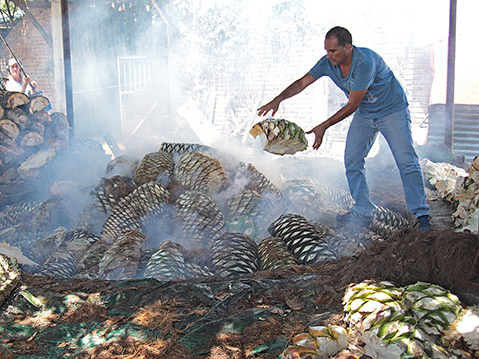
Though blue agave-based tequila is riding the popular liquor wave right now, very few realize how integral the whole family of agave plants was to the lives of Mesoamerican people throughout the ages. This documentary, narrated hauntingly by Edward James Olmos, dives into that cultural, spiritual, economic, and culinary history while also revealing a rebirth in respect for the plant in the present day.
Why make a documentary about agave?
It is the second in our series on indigenous foods of the Americas, the first being a documentary film and book about chocolate called Chocolate: Pathway to the Gods. Both chocolate and agave were critically important resources to native Mesoamerican peoples thousands of years ago and this is little recognized. In the end, we felt that agave would make a very compelling story that would link our present love affair with mezcals and tequilas with their fascinating history.
Do you think many people realize how many uses there are for the plant?
People who have lived in or spent considerable time in Mexico probably know this as do many gardeners, botanists, archaeologists and other specialists. But no, most people are probably not aware of the many potential uses.
Why are most not aware of how critical agave was to the early Americas?
On the one hand, few people seem knowledgeable about the detailed use of any specific resource in the prehistoric era. On the other hand, archaeologists themselves have only begun to realize this signal importance over the past few decades as more data have become available on widespread uses and the domestication of agaves throughout what botanist Howard Scott Gentry called “Agaveland.”
How is the Mescalero tribe doing?
The Mescalero face many of the same challenges as other Native American groups do in today’s society, but they are a proud people and willing to overcome whatever obstacles come their way to preserve their ancient culture. The population has been growing slowly throughout the 20th and early 21st centuries. From only a few hundred peoples when the reservation was established at the beginning of the twentieth century, the tribe has grown to more than 3,000 members today. Agave no longer has the importance within the tribe that it once had, but all of the members recognize its ceremonial role and it is likely to continue to be a part of ritual. Many tribal members also seem to still consider it a sweet treat.
The interdependence of agave and humans is also quite fascinating.
Agave’s many uses made it a critical early resource. Throughout Mexico and the American Southwest, native groups used it as a primary source of fiber for tools, construction, and clothing. The use as fiber may have been the earliest and most important. We suspect it is from this early use that images of rope became an integral part of imagery in early Mesoamerican art, from cave art such as that seen at White Shaman shelter in our documentary to rope imagery in important cultural contexts among the Olmec and the early Zapotec capital at Monte Alban in Oaxaca. Even today many people in Mexico depend upon agave for a livelihood — to the point where Eric Hernandez, the mezcal maker we interviewed in the film, said at one point that he though the Mexica flag should have featured an agave plant instead of a prickly pear.
How did you secure Edward James Olmos as the narrator?
We always felt that the narration would be critical and wanted an authoritative and perhaps somewhat exotic or mysterious sounding voice to bolster agave’s role in ritual and ceremony. At one point we considered having a female voice narrate the film, speaking for the goddess Mayahuel. In the end, we thought Olmos’ low-pitched, breathy voice conveyed exactly the feeling we wanted. We didn’t think we had a chance to recruit him, however, for our modestly budgeted documentary, but our cinematographer and our editors encouraged us to try, which we did. To our surprise, he accepted, saying that he thought it was a good film that made a very important point about losing our connection to the past.
What do you hope will be the impact of this film?
We hope that many viewers will see the agave plant in a different light. But even more important, perhaps, we would like people to understand that, for many traditional peoples, plants are much more than calories or a sweet treat, but rather an integral part of their culture and identity, even worshipped as gods in some cases. Agave is just one beautiful example of how a plant can be so much more than just a plant in a cultural context.



